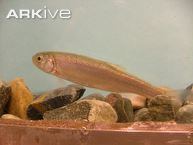Kingdom Animalia Subfamily Leuciscinae Phylum Chordata Rank Species | Family Cyprinidae Scientific name Snyderichthys copei Higher classification Snyderichthys Order Cypriniformes | |
 | ||
Genus Snyderichthys
R. R. Miller, 1945 Similar Spinedace, Utah chub, Least chub, Mountain sucker, Utah sucker | ||
The leatherside chub, Snyderichthys copei is a cyprinid fish of western North America.
This is a small fish, reported at up to 15 cm (6 in) in length, but more typically half that. The tapered body is covered with very small scales over a skin with a leathery texture, inspiring the common name. Overall color is bluish dorsally and silver ventrally; males are distinguished by patches of orange-red color on the axils of the paired fins, at the base of the anal fin, and along the lower lobe of the tail, as well as golden-red specks at the upper end of the gill opening, and between eye and upper jaw. Unlike most other minnows, both dorsal and anal fins have eight rays.
Its habitat is cooler creeks and rivers with moderate currents, where the adults congregate in pools or riffles, while the young favor quiet areas with brush near the shore.
Leatherside chubs range from the upper Snake River system in Idaho and Wyoming south to the Sevier River in Utah, being commonly found in the rivers draining into the Great Salt Lake and Utah Lake. They have been introduced into the Colorado River system, such as Strawberry Reservoir and Price River in Utah.
This chub has been extensively used as fishing bait.
Originally named Squalius copei and later placed in Gila, this chub was separated into a monotypic genus in 1945. This placement was eventually verified using mtDNA 12S rRNA sequence data. It seems a fairly close relative of the spinedaces (genus Lepidomeda) and the spikedaces (genus Meda), but the phylogeny and indeed the validity of the proposed "plagopterin" clade is insufficiently resolved (Simons & Mayden 1997).
